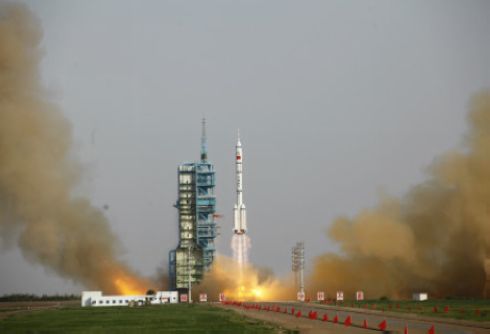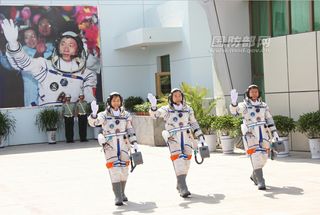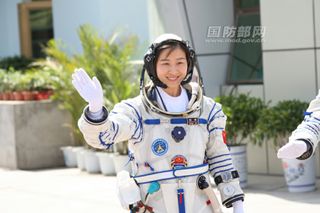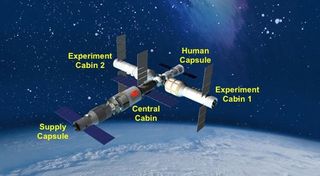China Launches 1st Female Astronaut and 2 Men to Space Lab

China launched three astronauts into space Saturday (June 16), kicking off an ambitous test mission that marks the country's first attempt to dock a manned spaceship in orbit and its first flight of a female astronaut.
The Chinese astronauts rode into orbit aboard the Shenzhou 9 spacecraft, which lifted off atop a Long March 2F rocket from the Jiuquan Satellite Launch Center in China's northern Gansu province at 6:37 p.m. local time (6:37 a.m. EDT; 1037 GMT).
If all goes according to plan, Shenzhou 9 will soon link up with the unmanned Tiangong 1 space lab, and China will become the third nation — after the United States and Russia — to perform a manned docking in Earth orbit.
The mission is considered a key step in China's ambitious space plans, which include the construction of a permanently staffed space station by 2020 and a manned moon landing sometime after that.
"The launch of the Shenzhou 9 is a highly influential event that marks an important milestone for the development of China's space technology," Cui Jijun, director of the Jiuquan Satellite Launch Center, said Wednesday (June 13), according to the nation's state-run Xinhua news agency. [Liftoff! Launch Photos for China's Shenzhou 9 Mission]
Once Shenzhou 9 reached orbit, cheers rang out at China's launch control center and Chang Wanquan, China's manned spaceflight program chief, declared the liftoff a success.
Historic mission
Sign up for the Live Science daily newsletter now
Get the world’s most fascinating discoveries delivered straight to your inbox.
China's president Hu Jintao commended the launch in a letter from Denmark, where he is currently paying a state visit to Copenhagen.
"I feel very glad to hear the success of launching the Shenzhou 9 manned spacecraft," Hu said in the letter, which was read by China state councilor Liu Yandong at the Jiuquan launch center shortly after liftoff.
The three taikonauts, as Chinese astronauts are known, include Jing Haipeng, Liu Wang and Liu Yang. The astronauts, clad in spacesuits, offered a salute as their rocket launched into space, then waved to cameras after reaching orbit.

Jing is China's first taikonaut to launch to space twice. He also flew on the Shenzhou 7 mission in 2008, which featured the country's first spacewalk. Liu Wang is a senior colonel in the People's Liberation Army making his first spaceflight.
Like her two male colleagues, Liu Yang, 33, is a former pilot with the People's Liberation Army and a member of the Communist Party of China.
Liu Yang is China's first female astronaut, and she blasted off on a historically appropriate anniversary. Forty-nine years ago today, on June 16, 1963, Soviet cosmonaut Valentina Tereshkova became the first woman in space; she ended up orbiting Earth nearly 50 times during her three-day mission.
The United States didn't launch a female astronaut until 1983, when Sally Ride flew on the space shuttle Challenger's STS-7 mission.
The Shenzhou 9 crew will remain in space for 13 days, Chinese space officials have said. During this time, they'll perform at least two separate dockings with Tiangong 1, a prototype space module that launched last September. The first docking will be automated, but then the two vehicles will separate to give the taikonauts a chance to drive.

"Then the astronauts will control the spaceship autonomously and realize manual rendezvous and docking with the target vehicle and form the complex again," said Wu Ping, spokeswoman for China's Manned Space Engineering Office, which oversees China's human spaceflight program.
The crewmembers will also "conduct scientific experiments, technological experiments, exercise and rest in Tiangong 1 target vehicle" during the mission, she added.
While Shenzhou 9's flight is China's first attempt at a crewed space docking, the nation has successfully linked up two robotic spacecraft in orbit. In November, the unmanned Shenzhou 8 craft docked twice with Tiangong 1 before returning safely to Earth.
The various Shenzhou docking missions are seen as important steps along the path to building a permanent space station in orbit. China hopes to have a 60-ton station up and running by 2020. (For comparison, the $100 billion International Space Station weighs about 430 tons.)

China's big space plans
The space-station effort is part of China's bold human spaceflight plans. It's just the third country, after Russia and the United States, to develop spacecraft capable of flying humans to space and back. Before today, China had launched three manned space missions, one each in 2003, 2005 and 2008.
And China's space ambitions don't end in Earth orbit. The country also hopes to land a taikonaut on the moon sometime after its space station becomes operational, officials have said.
China is also ramping up its unmanned space activities and capabilities.
In December, for example, the country joined the United States and Russia as the only nations with operational homegrown satellite navigation systems. China's Beidou system is somewhat rudimentary at the moment, consisting of just 13 satellites and providing incomplete coverage.
However, China envisions a global system with more than 30 satellites by 2020. The country hopes Beidou's emergence will make it far less dependent on the GPS constellation, which is operated by the United States military and is currently the world's dominant satellite navigation network.
Follow SPACE.com senior writer Mike Wall on Twitter @michaeldwall or SPACE.com @Spacedotcom. We're also on Facebook and Google+.












